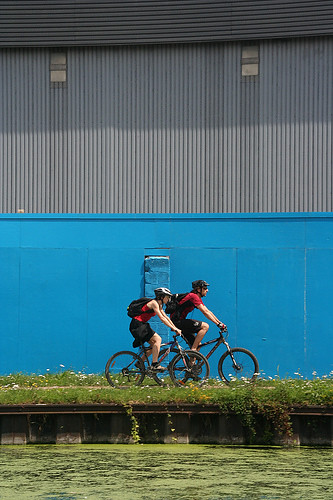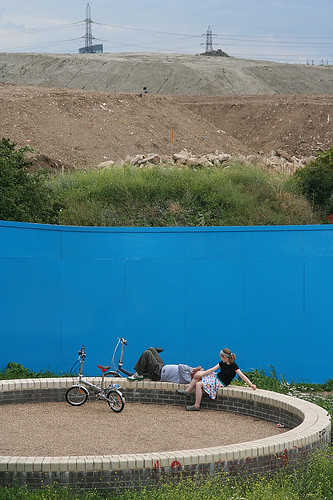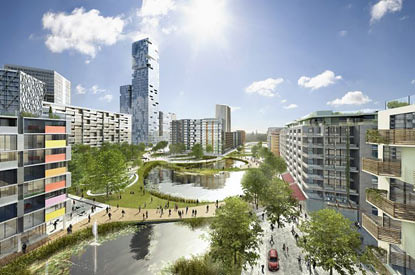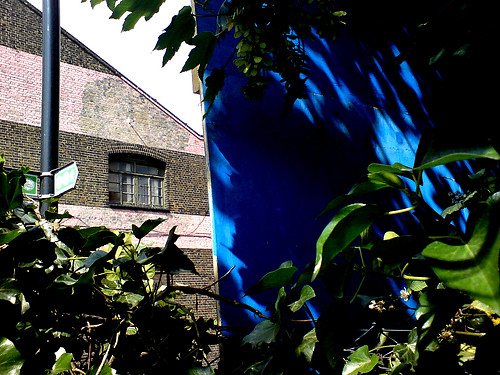Imperial Blue

[Image: Via johanna at Flickr.]
An excellent article by journalist Andy Beckett appeared in The Guardian a couple of days ago. He and local sculptor Silke Dettmers took a long and circuitous walk to trace the sudden geography of a 10ft tall 11-mile long blue fence, Beckett tells us, that “has sprung up around the 2012 Olympics site in east London.” Designed to secure a ‘city-within a city’ this meandering and unmistakably visible blue reef barrier, if you will, has lapped up massive swaths of Hackney Wick and Stratford.
But the color choice is certainly intriguing. The blue he describes is “a vivid, electric cyan that dazzles the eye” and “seemingly has little to do with any blue in the natural world.” Indeed this blue is everything the opposite of a wall that tries to blend in or oppress with some brutalist color or texture – instead it is meant to be enjoyable on some level, and seen from great distances by all except perhaps the blind themselves. It is more than a spectacle, it uses spectacle as its cover. By using such a sarcastically-refreshing color like this one the enclosure quietly mocks the openness of a space where no such barriers would ever need to exist, and in this way it is a blue completely unto itself; it is above all a politically charged blue (not much unlike the blue of the UN), it is a very carefully selected blue; like a hardened ribbon of pseudo-sea or sky that has woven itself across the land space, and by virtue of this blue the fence alludes to an open space that will never exist -- rubbing in the residents faces just the opposite in fact. It is this new imperial blue that calls the gaze to itself only to provide a highly privatized corporate veil for the coveted development of what will take “almost half a decade” to build Beckett writes, or “until the Olympic facilities are finished.”

[Image: Via inthebeginningwaslig ht at Flickr]
If walling were an urban sport of sorts in addition to being a candidate for Mayor (as we recently cited in Flint), then this would no doubt be its biggest event.
Or, when the walls aren’t busy narrating the collision courses of history, they are running rampant through the city – you might say it’s the longest billboard in recorded history, stitching and branding the sidewalks and countryside with the shadowy shape of a snaking global corporatism.
If Fenceland is indeed The Greatest Show On Earth, then this blue stroll is most certainly the Olympic Boulevard of Broken Dreams.

[Image: Via inthebeginningwaslig ht at Flickr]
The timing is almost impeccable, too: as APEC exits stage right the Olympics enters stage left. The nomadic fortress obviously needs next to no time to rest. But, more interesting this time around is not the question of whether Fenceland is a traveling performance piece for a kind of transnational “security theater” (again, as I saw it in Australia just weeks ago where the same blue was used in some instances, and Germany just weeks before that), but more so this time as something akin to Cirque de Soleil in that ‘the show’ embeds itself into the city, cementing its tendrils, instigating mass redevelopment projects through colossal corporate squats, promising a new local economy (just don't mention the debt along the way), minimizing its own need to travel, instead institutionalizing itself with clone-like expansion.

[Image: Via Evening Standard, Olympic village unveiled as £2bn legacy for London.]
A couple weeks ago I asked whether Sydney would see any permanent complexion changes in the city as a result of the sweeping APEC spectacle that had temporarily re-imaged the CBD, and whether the temporary had merely been used as a means to integrate more subtle changes in the permanent security landscape there. Well, by the looks in East London there can be no doubt, the landscape here will be forever altered by this temporary border fence and everything that is going on behind it – might this be the first stage of a longer lasting security strategy?
Would this even be really any surprise?

[Image: Via CABE, Olympic, Paralympic and Legacy Transformation masterplans]
It’s a long article but a must read as far as I am concerned. Beckett gets into how certain demographics are being re-shifted, how boroughs redrawn, historical culture erased; how the fence is also being used as a long-winded advertisement for global capital messaging, and least of all, how it symbolizes the pretentious nature of the Olympic games itself, how they are planned, who will get to participate in them, and ultimately who will in essence get to partake in seeing them. It is, as his case makes to some extent, the emblem of an Olympic sham; a politics of ‘microbordering’ that carefully carves sites of wealth with both blatant and disguised forms of exclusion. We see this type of development in every city where the Olympics takes hold: mass displacements of people, homeless swept out of view, communities completely uprooted for stadiums and Olympic cities that often dry up afterwards leaving nothing but a permanent scar on the landscape: an Olympic ghost town when all is said and done.

[Image: Via Martin Deutsch at Flickr.]
Beyond that this blue fence is a look at different walled-cities in context of one another, not to mention how these walls transport imaginary geographies from the outside to the inside, from the other to the familiar - the normalization and internalization of capital's frontier.
Ahhh...nothing I haven't already stumbled to articulate before.







3 Comments:
Fences build good neighbors.
in regard of the olympic village, many artists are being slowly evacuated out of hackney wick. typical gentrification process....
Mr. Gorbachov, Tear down this wall!
OR
Blue Tie Guy
Post a Comment
<< Home